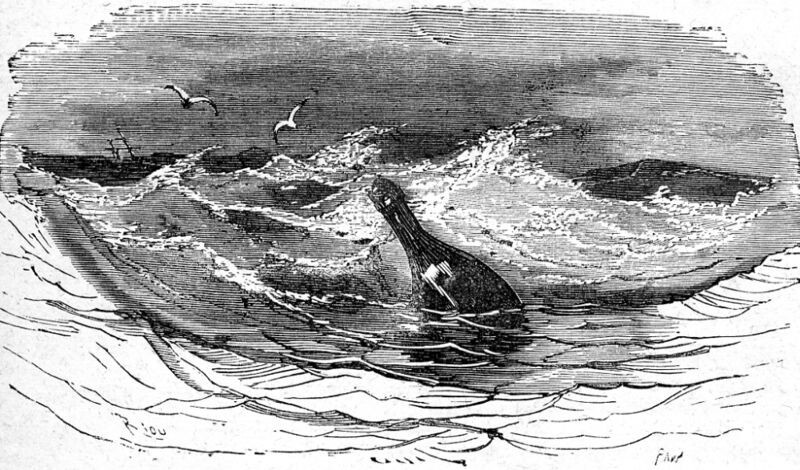Bottle mail. Last chance to let you know about the trouble that has befallen you (4 photos)
A bottle rocking on the waves, so overgrown with algae that one can barely guess that it is a bottle and not a bunch of algae and other sea plants. Inside is thin old parchment, rolled into a tube, and the neck is tightly sealed with sealing wax. This is exactly how people imagine this ancient way of conveying information about themselves. Pirates, Robinsons, hermits or castaways. 
Theophrastus
All this is associated with bottles with a letter inside, floating in the ocean at the will of the current and waves. In fact, the history of this kind of messages is much older than it might seem.
The tradition of throwing a message to the waves and wind dates back to the distant past, and, most likely, no one will ever know who was the first person to think of this. Today it is believed that the idea belongs to the Greek scientist and philosopher Theophrastus. Around 310 BC. he threw into the sea beyond Gibraltar several bottles with parchment sealed inside to trace the current from the Atlantic to the Mediterranean. A few months later, these bottles were found on the coast of Sicily.
There are also interesting references to the use of the sea and currents to deliver messages in the ancient Japanese epic. The Tale of the House of Taira (The Tale of Heike) mentioned a poet condemned to exile, who wrote his messages on wooden tablets, telling about his fate, and launched them into the sea.
Actually, since ancient times, almost all ships of major maritime powers have used bottle mail in one way or another. It was a simple and inexpensive, although very unreliable method. And of course, the bottles contained mainly messages from ships that were in one or another difficult situation. Thus, Christopher Columbus, returning to Europe after the discovery of the New World, found himself in a severe storm and was not sure that he would get out of it alive. Then he wrote about his discoveries on waxed parchment with a request to convey this message to the king and queen, sealed it in a bottle and threw it into the sea. This message was never found.
For example, this story can tell you how long such a bottle can wander on the waves. In 1784, Chunosuke Matsuyama, a Japanese sailor, and his 43 comrades went to one of the Pacific islands in search of treasure. They were shipwrecked and stranded on a desert island with no food or food sources. Before their deaths, the sailors wrote a letter telling the story of their fate and, sealing it in a bottle, threw it into the sea. Surprisingly, the bottle fell into the hands of exactly the residents of the village where they were all from, but... only 151 years later.
Nevertheless, messages in sea "mail letters" have always been considered extremely important. Thus, in England, since 1590, there was a law that if anyone dared to independently uncork or break a bottle caught from the sea, then such a person would face the death penalty. At the court of the English queen, there was a special position of ocean bottle opener, which was considered very prestigious, and was usually occupied by a high-born lord. According to the recollections of contemporaries, Queen Elizabeth the First, when this man came to her, each time asked him with humor: “Well, what is Neptune writing to us?” The volume of such correspondence is indicated by the fact that in the first year alone after the establishment of the position of ocean bottle opener, no less than 52 bottles with letters were opened. 
Letter in a bottle
Mentions of bottle mail are found in one way or another in many documents of the sailing age, but one should not assume that after the steam engine replaced the sail, the practice of throwing bottles with messages into the ocean was abandoned. Glass containers with messages are still used to this day to study sea currents. Between 1907 and 1912, more than 10,000 bottles were thrown into the sea to study the Sea of Japan and Okhotsk.
One of the oldest bottles currently recovered from the ocean is considered to be one found on Australia's Moreton Island on June 6, 1983. Then a bottle thrown into the sea from the Aravatta steamship in 1910 was found on the shore.
Even now, the oceans of the Earth are still plied with thousands of bottles with messages to recipients who, most likely, have long since gone to another world. As in the example of the Japanese sailor, many of the bottle mail stories shed light on the tragedies of people who perished forever in the ocean due to storms, accidents, shipwrecks or even wars. It is not surprising that the gloomy, but at the same time romantic flair of such letters attracted the attention of the creative community, and bottles with messages became “regulars” among manymany books and stories.
Thus, in 1833, the story “The Manuscript Found in a Bottle” was published, which became the starting point for the worldwide fame of the writer Edgar Allan Poe. In Jules Verne's novel “The Children of Captain Grant,” it was the discovery of a bottle with a request for help that became the plot of the entire plot. The novel itself, as well as its author, were very popular in their time, and even now many remember the film adaptation of this work. And also a great many books and stories, as well as various film and radio shows, where bottles with messages were mentioned in one way or another. 
Bottle with a message, illustration for one of the first editions of Jules Verne’s novel “The Children of Captain Grant”
In conclusion, it is worth noting that a bottle with a letter has become an invariable attribute of the Age of Sail. When there was no other connection, throwing a bottle with a message overboard, one could at least hope that by the will of the waves the message would reach the addressee. In fact, such letters most often had purely utilitarian functions, such as studying sea currents or delivering correspondence from various intelligence services. By the way, some scientists believe that this is why in England there were such severe penalties for opening such bottles without permission from the authorities.
Requests for help were often delayed for years, if not decades, when there was no one to save. In history, there are several dozen truly happy cases when the bottle found its recipient, and the victim managed to get help. But for every such case, there are dozens, or even hundreds of others, when similar bottles serve only as a silent reminder of a tragedy that happened long ago.






























